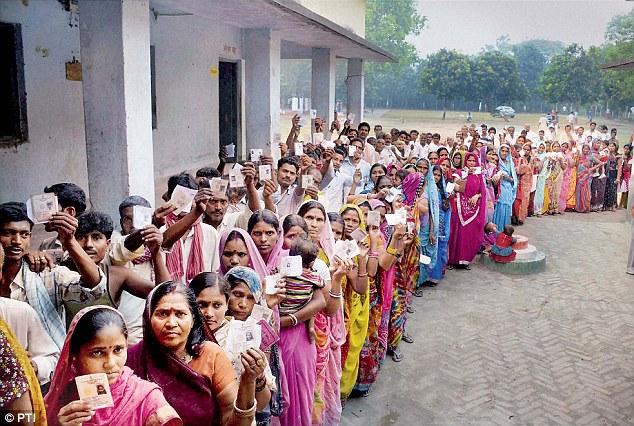A Silent Voter Gives a High Turn Out, But is Mum on Voicing His Preference: UP Polls

With 73 seats in the first phase, 67 seats in the second and on 19th feb in the third phase, elections to 69 (12 districts) more seats having concluded, the dye has figuratively been caste in 219 seats and the halfway marked crossed. Other predictions apart, these first three phases have been marked with a high voter turnout, that fact alone leading to speculation, hope and apprehensions. What is marked about this election in the politically significant state of Uttar Pradesh is the extremely silent voter across the state.
In the 1989 general elections, some stray political pundits say this had resulted in a sweep for the redoubtable VP Singh who all but wiped away Rajiv Gandhi’s historic sweep of 1984 that came after Mrs Indira Gandhi’s assassination.
But will the analogy hold true this time, when there is more than one ‘secular option’ for the voter? Can it be decisively predicted that one of the two ‘secular’ options benefit? Or, if -- as the tussle increasingly narrows down to one between a confident and resurgent BSP and the SP-Congress alliance -- will the BJP sneak in from the backdoor in over 70 seats where these two ‘‘secular options’ run too close to the finish? These are the questions that are dogging journos and pundits who are finding it more and more difficult to offer a prediction. Let’s wait for March 11, is the commonly uttered refrain.
Which are the sections of the voter that have turned out in large numbers in the first three phases? And who stands to gain from UP’s high voter turnout in the three rounds already polled?
What appears clear from the first three rounds is that large sections of the Dalits have come out to caste their ballot as have the Muslims. Among the Dalits, except for a small section who may still remain with the BJP, the vast majority appears to have come back to Mayawati. Among Muslims, the vote is divided and confused. Far from their substantive vote share of close to 18 per cent across the state and as high as 45 per cent in some constituencies being a decisive and ‘tactical’ anti-BJP vote block, this voter is divided, giving some cheer to the otherwise jittery saffron camp.
Take for example the Behat constituency of Sahranpur that in 2012 saw a stiff contest between the BSP and the Congress. The BSP has held the seat in the 14th, 15th and 16th Vidhan Sabhas with Dharam Singh Saini and Mahaveer Singh Rana. Today with two Muslims in the fray, one a Pasmanda Muslim, Haji Muhammad Iqbal for the BSP and Imran Masood for the Congress, the split is evident and the outcome hangs in the balance. Far from displaying any unity against communal-fascist forces, the ‘secular political options’ are divided here and all over UP. That is one example of a secular split from the first round of polls in the state.
In the third round of voting that included Kanpur city’s seats, again there is a clear division of the Muslim votes in two of the seats. So despite there being vibrant ‘secular’ options, the threat of a saffron candidate sneaking past cannot be wished away.
De-monetisation finds no mention in the BJP’s campaign, never mind that the prime minister and his coterie stubbornly continue to peddle the propaganda about it’s ‘overall good.’ No wonder then, that the BJP, led by Narendra Modi has now come down to what it does best, running a negative and even communal campaign.
Akhilesh Yadav, the sitting chief min ister of the state appeared to breeze in late into the contest when he managed to swing an alliance with the otherwise faltering Congress. While the Samajwadi Party seeks to retain the state - albeit with the Congress this time, the BSP and BJP hope to regain power in the state after five and 13 years respectively.
Details of Voter Turnout
In the first round, on February 11, it was an all-time high voter turnout of about 65 per cent in the first phase of the seven-phased Uttar Pradesh Assembly election and reports that first flowed in from the 73 Assembly constituencies, spread across 15 districts, and this polling indicated a high turnout of both Dalit and Muslim voters. This voter turnout in the first phase at 64.2 per cent – was an increase of nearly three per cent from the first phase turnout in 2012.
Then after voting was concluded in the second round on February 15, an equally impressive turnout of over 65% was recorded in 67 Assembly constituencies across 11 districts of western Uttar Pradesh. The districts where polling were held included Bijnor, Saharanpur, Moradabad, Sambhal, Rampur, Bareilly, Amroha, Pilibhit, Kheri, Shahjahanpur and Badaun.
The third phase that concluded yesterday, February 19 recorded 61.16 per cent of the vote regarded reasonably high. Last time, elections to this segment that include Farukhabad, Hardoi, Kannauj, Mainpuri, Itawah, Auriya, Kanour Rural, Unnao, Lucknow, Barabanki and Seetapur districts was at 59.96 per cent.
Sitapur in this segment was the highest at 69.50 per cent, followed by Barabanki at 68.13 per cent, Kanpur city at 67 per cent, Kannauj at 65.6 per cent, Kanpur Rural at 65 per cent, Farukhabad at 61.1. per cent, Itawah, Unnao and Auriya polled 61.61 per cent and it was Lucknow the capital that was the lowest at 58 per cent.
Disclaimer: The views expressed here are the author's personal views, and do not necessarily represent the views of Newsclick.
Get the latest reports & analysis with people's perspective on Protests, movements & deep analytical videos, discussions of the current affairs in your Telegram app. Subscribe to NewsClick's Telegram channel & get Real-Time updates on stories, as they get published on our website.














